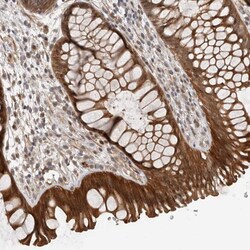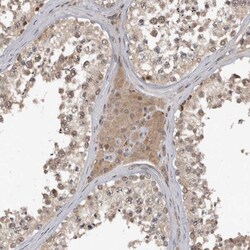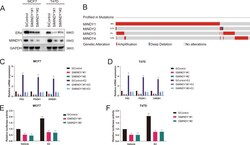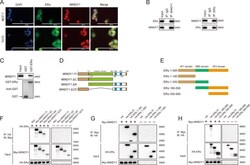Antibody data
- Antibody Data
- Antigen structure
- References [1]
- Comments [0]
- Validations
- Immunohistochemistry [5]
- Other assay [2]
Submit
Validation data
Reference
Comment
Report error
- Product number
- PA5-55825 - Provider product page

- Provider
- Invitrogen Antibodies
- Product name
- FAM63A Polyclonal Antibody
- Antibody type
- Polyclonal
- Antigen
- Recombinant protein fragment
- Description
- Immunogen sequence: FPSYWTGHSF ASQAWLRQVP EVSKHLQCPS AESLLTMEYH QPEDPAPGKA GTAEAVIPEN HEVLAGPDEH PQDTDARDAD GEAREREPAD QALLPSQ Highest antigen sequence identity to the following orthologs: Mouse - 38%, Rat - 29%.
- Reactivity
- Human
- Host
- Rabbit
- Isotype
- IgG
- Vial size
- 100 μL
- Concentration
- 0.10 mg/mL
- Storage
- Store at 4°C short term. For long term storage, store at -20°C, avoiding freeze/thaw cycles.
Submitted references MINDY1 promotes breast cancer cell proliferation by stabilizing estrogen receptor α.
Tang J, Luo Y, Long G, Zhou L
Cell death & disease 2021 Oct 13;12(10):937
Cell death & disease 2021 Oct 13;12(10):937
No comments: Submit comment
Supportive validation
- Submitted by
- Invitrogen Antibodies (provider)
- Main image

- Experimental details
- Immunohistochemical analysis of FAM63A in human rectum using FAM63A Polyclonal Antibody (Product # PA5-55825) shows strong cytoplasmic positivity in glandular cells.
- Submitted by
- Invitrogen Antibodies (provider)
- Main image

- Experimental details
- Immunohistochemical analysis of FAM63A in human testis using FAM63A Polyclonal Antibody (Product # PA5-55825) shows moderate cytoplasmic positivity in Leydig cells and cells in seminiferous ducts.
- Submitted by
- Invitrogen Antibodies (provider)
- Main image

- Experimental details
- Immunohistochemical staining of FAM63A in human thyroid gland using a FAM63A Polyclonal Antibody (Product # PA5-55825) shows cytoplasmic positivity in glandular cells.
- Submitted by
- Invitrogen Antibodies (provider)
- Main image

- Experimental details
- Immunohistochemical analysis of FAM63A in human cerebral cortex using FAM63A Polyclonal Antibody (Product # PA5-55825) shows moderate cytoplasmic positivity in neuropil and a subset of neuronal cells.
- Submitted by
- Invitrogen Antibodies (provider)
- Main image

- Experimental details
- Immunohistochemical analysis of FAM63A in human skeletal muscle using FAM63A Polyclonal Antibody (Product # PA5-55825) shows moderate cytoplasmic positivity in myocytes.
Supportive validation
- Submitted by
- Invitrogen Antibodies (provider)
- Main image

- Experimental details
- Fig. 1 MINDY1 depletion decreases ERalpha signaling activity in breast cancer cells. A MINDY1 depletion decreased ERalpha protein level. B Genetic alternations of MINDYs in breast cancer. MINDY1 was amplificated in 18% of breast cancer patients. The OncoPrint schematic was constructed in cBioPortal (TCGA dataset) to directly reflect all types of alterations such as amplification, deep deletion of the MINDY genes from 1084 breast cancer patients. C , D MINDY1 depletion decreased ERalpha target genes in the absence or presence of estrogen. Breast cancer cells were transfected with si MINDY1 or siControl. After 48 h, cells were treated with either ethanol or 10 nM estrogen for 6 h. Total RNA was prepared and the expression of the endogenous ERalpha target genes, PS2, GREB1, and PDZK1 were determined by qRT-PCR. E , F MINDY1 depletion affected ERE-luciferase activity. Breast cancer cells were transfected with siMINDY1 or siControl together with ERE luciferase reporter plasmid. Cells were treated with 10 nM estrogen or vehicle. Luciferase activity was measured 48 h after transfection. The experiment was independently repeated three times with three replicates. * P value < 0.05; **P value < 0.01; ***P value < 0.001.
- Submitted by
- Invitrogen Antibodies (provider)
- Main image

- Experimental details
- Fig. 4 MINDY1 associates with ERalpha. A An immunofluorescence assay demonstrated that MINDY1 and ERalpha at least partially colocalized in MCF7 and T47D cells. B Co-IP assay revealed an association between endogenous MINDY1 and ERalpha in MCF-7 cells. MCF-7 cells were harvested with RIPA lysis buffer. Co-IP was performed using antibody as indicated. C Purified His-MINDY1 was incubated with GST- ERalpha or GST protein. The interacted MINDY1 was detected via western blot. D ER alpha domain structure and deletion mutants used in the study. D , E ERalpha and MINDY1 domain structure and deletion mutants used in the study. F The catalytic domain of MINDY1 interacted with ERalpha. HEK293 cells were transfected with 2 ug HA-ER alpha together with Myc-MINDY1 full length or mutants. After 24 h, cells were harvested with NP-40 lysis buffer. Co-IP was performed using HA antibody. The possible interacted MINDY1 domains were detected by Myc antibody. G , H MINDY1 interacted with ERalpha through its AF1 domain. HEK293 cells were transfected with 2 ug Myc-MINDY1 together with HA-ERalpha full length or mutants. After 24 h, cells were harvested with NP-40 lysis buffer. Co-IP was performed using Myc antibody. The possible interacted ERalpha domains were detected by HA antibody. The experiment was independently repeated three times with three replicates.
 Explore
Explore Validate
Validate Learn
Learn Immunohistochemistry
Immunohistochemistry